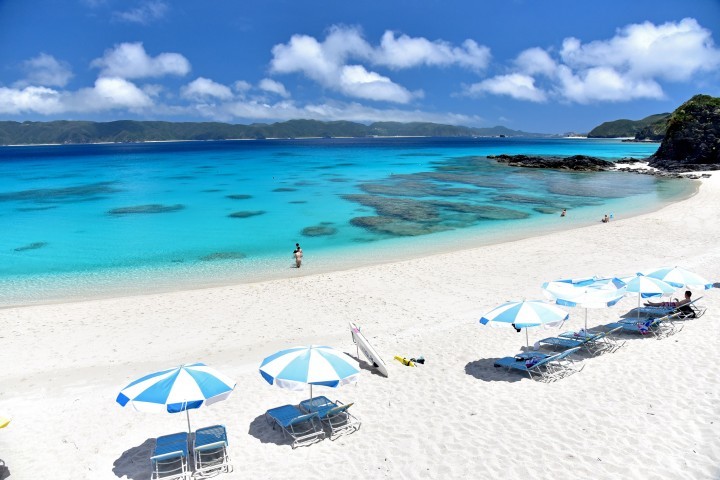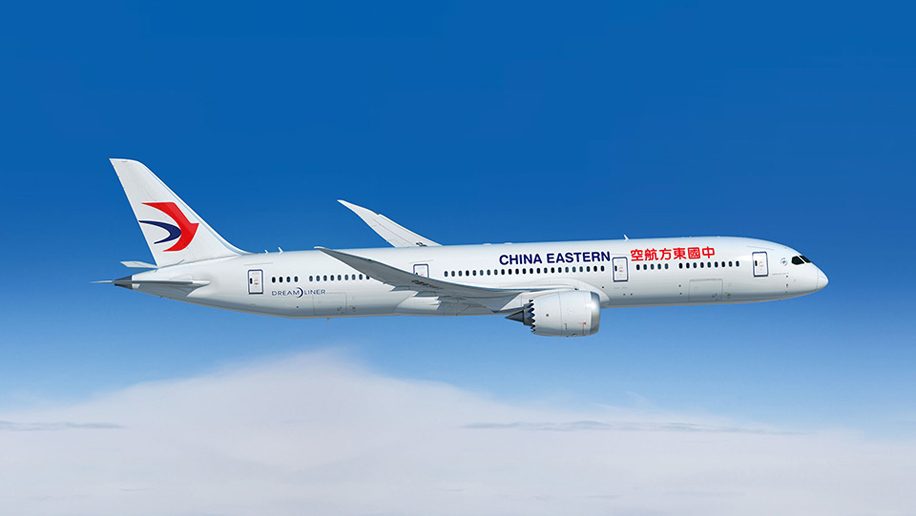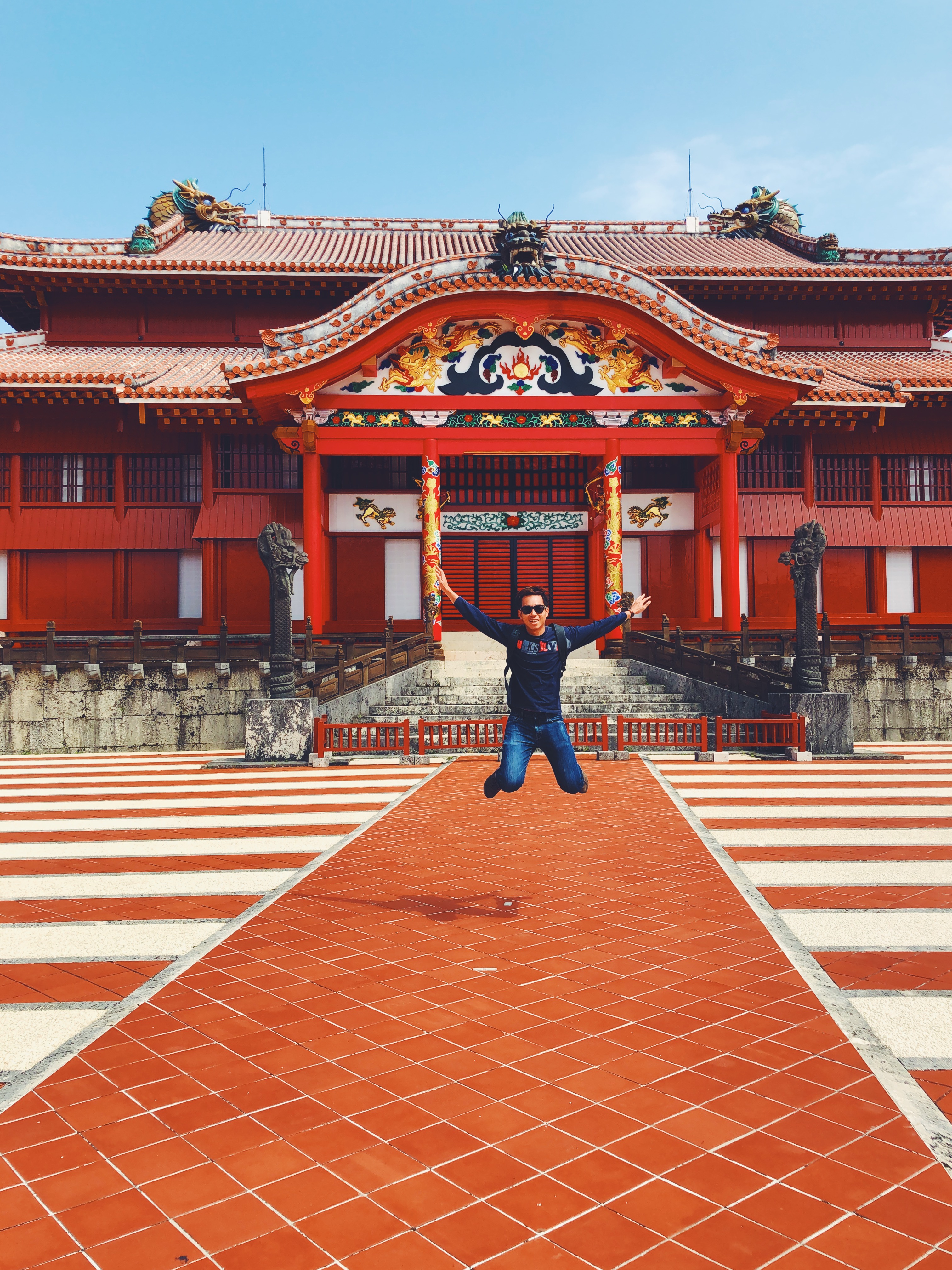

Day 1: Flight to Naha, arrival at airport, collect rental car and drive to Yomitan
Day 2: Explore Yomitan Zakimi castle ruins, Cape Zanpa lighthouse. Drive north to Ogimi longevity village, visit Cape Hedo (northernmost point of Okinawa)
Day 3: Wanted to see the whales in Chatan but there was no boat going out due to the rough seas. Went to American Village and drove to Naha – Shuri castle, Zuisen sake distillery tour, walk around International Street.
Day 4: Nuchi-una Sightseeing and Salt Factory and the beaches around the area. Check out Ikei, Tonnaha and Akuna beach
Day 5: Okinawa Memorial Park Ocean Expo Pavilion and Okinawa Churaumi Aqaurium
Day 6: Diving at the Blue Hole, visit Okinawa World for the cave and traditional village. Souvenir shopping at Okashigoten Onna with sweet potato tart making workshop, sunset at Cape Manzamo.
Day 7: Last minute shopping at Ashibina Outlet Mall, before heading to the airport for our flight home.
Sitting about 640 kilometers south of Japan’s Kyushu island, Okinawa’s main appeal for travelers is that its two dozen or so islands are ringed with crystal-blue tropical waters and white sand beaches.

Okinawa can be compared to the Hawaii of Japan due to its year-round tropical climate. When we visited in March, the weather was cool, around 21 deg while the rest of Japan was hovering around 10 deg. It is an idyllic escape for Japanese who seek some warmth and the sun. Being geographically closer to Taiwan than to Tokyo, with a minimum of 9 daily flights between Taipei and Naha, it is also convenient to hop on a short one and a half hour flight from Taipei.

This red temple complex known as Shurijo castle was the administrative center of the Ryukyu kingdom, and was the focal point of foreign trade, as well as the political, economic and cultural heart of the Ryukyus. In 2000, along with other gusuku and related sites, it was designated as the 11th UNESCO World Heritage Site for its unique structure and architecture that have combined Japanese with Chinese styles.


“Paradise”. That’s what this place should be called as only a few steps will take you to a tiny yet beautiful beach, with huge rock formations that you can climb up for photo opportunities. This place is known as Diamond Beach and there is a cafe where you can enjoy some food and drinks while looking out towards the sea.

When visiting Okinawa, it is inevitable to indulge in some sweet potato tarts (beni-imo). What a better way to appreciate the tarts is to attend a baking workshop, at their flagship Okashi Goten store in Onna village.

As their factory is adjacent to the shop, freshly made pastry can be enjoyed and its flavours will exceed your expectations. Whether you’re here for shopping or just browsing, you can have a chance to experience of making your own Beni-imo tarts and observing its manufacturing through the window.

Over at Okinawa World, it offers an Okinawan cultural experience where you can glimpse its history as well. With a total length of five kilometers, Gyokusendo Cave is the longest of the many caves in the south of Okinawa Island and the second longest cave in the entire country. 850 meters of the cave are open to the public and feature spectacular stalactites and stalagmites. The inside of the cave is well maintained and the walking paths are comfortable and well lit. It is amazing how the caves have developed by the dripping effect of seawater to form such a magnificent structure today.

On the outside, there are areas of old houses designated as cultural property and of Habu where you can touch and learn about. The Kingdom Village is a nice replica of a traditional Ryukyu village with workshops introducing the various traditional Okinawan crafts, such as weaving, dyeing, paper making, pottery, sugar cone processing, the making of music instruments and the more recently introduced glass blowing.

At selected timings during the day, there is also an exciting traditional drum show “Super Eisaa”.

Known as Japan’s best aquarium, Churaumi aquarium attracts both adults and children alike. The highlight of a visit to the Churaumi Aquarium is the massive Kuroshio Tank, one of the largest in the world. The tank takes its name from the warm Kuroshio current which plays a large part in the variety of Okinawa’s of marine life. The tank contains a wide variety of species, the most striking of which are the giant whale sharks and manta rays. Even though ethical concerns may arise about the captivity of the whale shark, I believe that the animals are well taken care of and they also serve as an educational purpose.

In addition to the main aquarium building, there are a few outdoor pools near the waterfront where animal shows of dolphins, sea turtles and manatees can be viewed free of charge. The aquarium is very informative and there are also interactive exhibits, which makes it suitable for children. They get to learn a lot about marine creatures, their adaptations in the various environments and can touch a sea cucumber or starfish with their bare hands.

As we drove across the causeway bridge from mainland Okinawa to Miyagijima, it feels like we are transported to another island. This chain of three islands (Henzajima, Miyagijima and Ikejima) feel more laidback than the rest of Okinawa. It is home to the Nuchi-una sightseeing and salt factory, which offers free informative tours to learn more about the natural salt through the large windows.What you can’t miss at this factory is the beautiful snow-like salt scene which can be seen through the large windows.

After walking through the process, treat yourself with the delicious dishes with use of salt made 100% from Okinawan sea water, such as Okinawa soba, curry and rice, pasta as well as desserts. We tried the salted ice cream which was simple yet refreshing.

Spectacular views of emerald green ocean can be observed from its premises as well. We took a short walk along the cliff to view the magnificent bay area. It is a popular spot among locals who go to this secret beach to sunbathe without the tourist crowds.

Back in downtown Naha, if you are planning to do some last minute shopping, head over to this shopping street. Kokusaidōri, literally “International Road”) is Naha’s main street, stretching for roughly two kilometers through downtown Naha. The street takes its name from the former “Ernie Pyle International Theater”, a movie theater that was built along the road after the war. From souvenirs to clothes to fresh food, the shopping street sells the gamut.

Another place for shopping is the American Village. Many American military bases are located in the area, and the entertainment complex’s theme of Americana provides a nostalgic pleasure for residents of the bases as well as an interesting diversion for the locals. The Mihama American Village resembles a big American outdoor shopping mall with lots of shops, restaurants, cafes and a large parking lot. You can enjoy a meal at one of the restaurants here or shop for souvenirs, clothes etc. The large Ferris wheel in the middle of the village serves as a landmark.

Due to the long coastline with several headland and bay areas, it makes it scenic to drive along the coastal roads of Okinawa and stop at several capes along the way for sightseeing. Here at Cape Manzamo, it is a scenic rock formation on Okinawa Island, Japan. It is located near Onna Village in the Kunigami District of Okinawa Prefecture. Cape Manzamo is one of the most popular places among tourists.

If you take a stroll along the windswept walkway, you will see an elephant-trunk-shaped coral cliff for which the location is famous, and that is what will take your breath away. Besides the spectacular views of the ocean, you can also see waves crashing into the cliffs and feel at peace with the sea breeze, accentuated by the splendid sunset.

Driving all the way up north on Okinawa main island, you will reach Cape Hedo. North of Nago, Okinawa Honto is only scarcely populated and mainly covered by forests and hills. Cape Hedo is the island’s northernmost tip, offering spectacular views of the cliffy coast.

En route, we also stopped at the longevity village of Ogimi, which is is world famous due to the number of centenarians that live there. We had a set lunch of longevity meal, made up of sixteen small dishes, consisting mainly of vegetables and some portions of meat. The meal was served in an intricate manner and even though the portions look small, we were totally full after finishing everything.

At another point, Cape Zanpa is marked with a tall whitewashed 30m lighthouse. From the top of a cliff, it offers a great opportunity to capture a view of a lifetime. There is also a small fun petting zoo and the largest Shi-shi dog in Okinawa right by the large parking lot. Explore the trails behind the lighthouse as well for some picturesque views.

Lastly, this is the only spot where tourists can experience the great view not only from the upland, but also from under sea, as recommended by my host. Cape Maeda is known for the famous blue cave which attracts divers and snorkelers. It is known for its coral plateau located on the west coast of central Okinawa.
Huge rocks lie among the tip of cape formed by the raised coral reef, and right underneath you will be able to see one of Okinawa’s clear emerald green ocean with its beautiful coral reef. It is advisable to go early to see the blue cave as it can get really crowded with tourists after 8am.
Looking up from above as you are in the cave, you would see the reflected light that shines upon the ceiling inside the cave—the result of this is that you can see blue shining throughout the entirety of the cave. This beautiful blue color is the result of geographical features created by nature. Although I did not manage to hold my breath and dive till quite deep, I still managed to catch a glimpse of the blue light shining through the cave.
There’s so much to see and do in Okinawa. One trip is not enough, I would definitely be back again and perhaps check out the other outlying islands such as Ishigaki next time.
How to fly here?
We flew on China Eastern airlines ($350-$500) via Shanghai. There are many airlines that fly to Japan, so you can first fly to Tokyo on ANA, Japan Air, Singapore Airlines, before transferring to a domestic airline to Okinawa. Flying to Tokyo first would be a longer route as the plane would have to fly over Okinawa, then fly south again for another two hours from Tokyo to Naha.
Alternatively, Peach airlines (B8000 ~$360 round-trip) has occasional cheap flights from Bangkok to Naha daily. Tigerair Taiwan ($225 round-trip) also flies direct from Taipei to Naha twice daily. From Singapore, the only direct flight is the four times weekly Jetstar flight ($300 return), departing on Sundays, Mondays, Thursdays and Fridays. The price was almost the same as a full-service airline and the timing was not so suitable, which is why we chose to fly with China Eastern instead.


